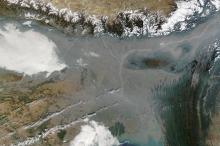MIT Joint Program researchers advocate for improved modeling approach.
How might climate change affect the acidification of the world’s oceans or air quality in China and India in the coming decades, and what climate policies could be effective in minimizing such impacts? To answer such questions, decision makers routinely rely on science-based projections of physical and economic impacts of climate change on selected regions and economic sectors. But the projections they obtain may not be as reliable or useful as they appear: Today’s gold standard for climate impact assessments — model intercomparison projects (MIPs) — fall short in many ways.
MIPs, which use detailed climate and impact models to assess environmental and economic effects of different climate-change scenarios, require international coordination among multiple research groups, and use a rigid modeling structure with a fixed set of climate-change scenarios. This highly dispersed, inflexible modeling approach makes it difficult to produce consistent and timely climate impact assessments under changing economic and environmental policies. In addition, MIPs focus on a single economic sector at a time and do not represent feedbacks among sectors, thus degrading their ability to produce accurate projections of climate impacts and meaningful comparisons of those impacts across multiple sectors.
To overcome these drawbacks, researchers at the MIT Joint Program on the Science and Policy of Global Change propose an alternative method that only a handful of other groups are now pursuing: a self-consistent modeling framework to assess climate impacts across multiple regions and sectors. They describe the Joint Program’s implementation of this method and provide illustrative examples in a new study published in Nature Communications.
The Joint Program method is essentially a next-generation Integrated Assessment Model (IAM). IAMs typically come in two forms — either as simple climate models coupled with algorithms that translate increases in average global surface temperature into environmental and economic damages known as the social cost of carbon; or as more detailed Earth-system models with continually improving representation of physical impacts, coupled with economic models. The Joint Program IAM integrates a geospatially resolved physical representation of climate impacts into a coupled human and Earth system modeling framework.
Developed over the past 26 years, the MIT Integrated Global System Modeling (IGSM) framework allows researchers to custom-design climate-change scenarios and assess climate impacts under those scenarios. For a given climate change scenario, they can use the framework to analyze the chain of physical changes at the regional and sectoral levels, and then estimate economic impacts at those levels.
“The IGSM framework makes it possible to do multisectoral climate impact assessment within a single modeling framework within a single group,” says Erwan Monier, lead author of the study and a principal research scientist at the Center for Global Change Science and the MIT Joint Program. “It’s responsive to changes in environmental policies, internally consistent, and much more flexible than multimodel international exercises.”
In the study, Monier and his co-authors applied the IGSM framework to assess climate impacts under different climate-change scenarios — "Paris Forever," a scenario in which Paris Agreement pledges are carried out through 2030, and then maintained at that level through 2100; and "2C," a scenario with a global carbon tax-driven emissions reduction policy designed to cap global warming at 2 degrees Celsius by 2100. The assessments show that "Paris Forever" would lead to a wide range of projected climate impacts around the world, evidenced by different levels of ocean acidification, air quality, water scarcity, and agricultural productivity in different regions. The "2C" scenario, however, would mitigate a substantial portion of these impacts. The researchers also explored additional scenarios developed by Shell International regarding the potential development of low-carbon energy technologies.
“These examples showcase the responsiveness, consistency and multisectoral capability of our approach, which we believe represents a promising direction for the climate impact modeling community,” says Sergey Paltsev, a co-author of the study and deputy director of the MIT Joint Program, as well as a senior research scientist at the MIT Energy Initiative and the MIT Center for Energy and Environmental Policy Research. “Unlike traditional IAMs and MIPs, the improved coupled human-Earth system models like the IGSM framework enable researchers to design new emissions scenarios in a matter of months rather than years, avoid inconsistencies among different model components and scenarios, and analyze multiple sectors all at once.”
Figure caption: Air pollution in Bangladesh and Northern India. (Photo Jacques Descloitres, MODIS Rapid Response Team, NASA/GSFC)
Link to article:



